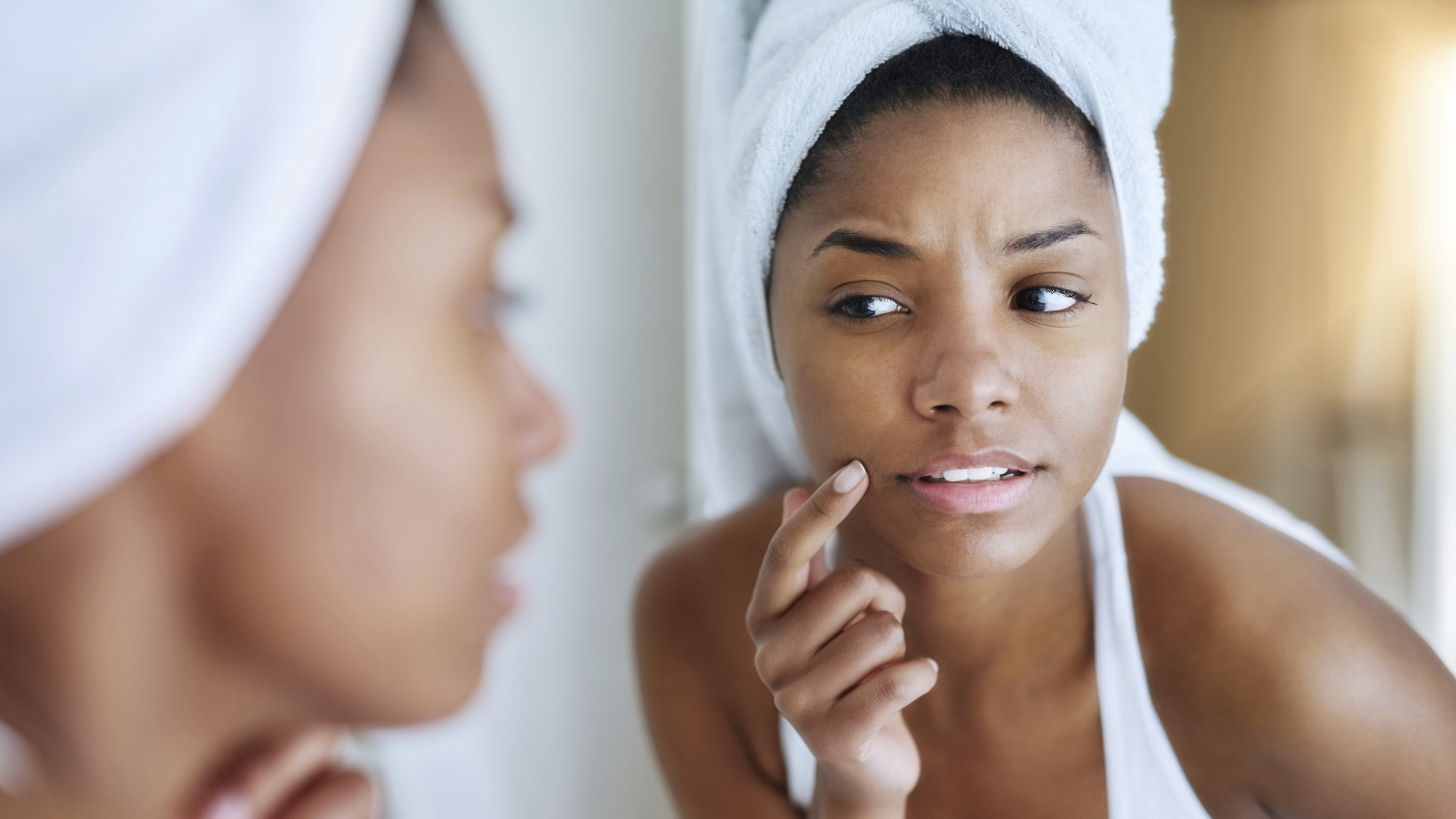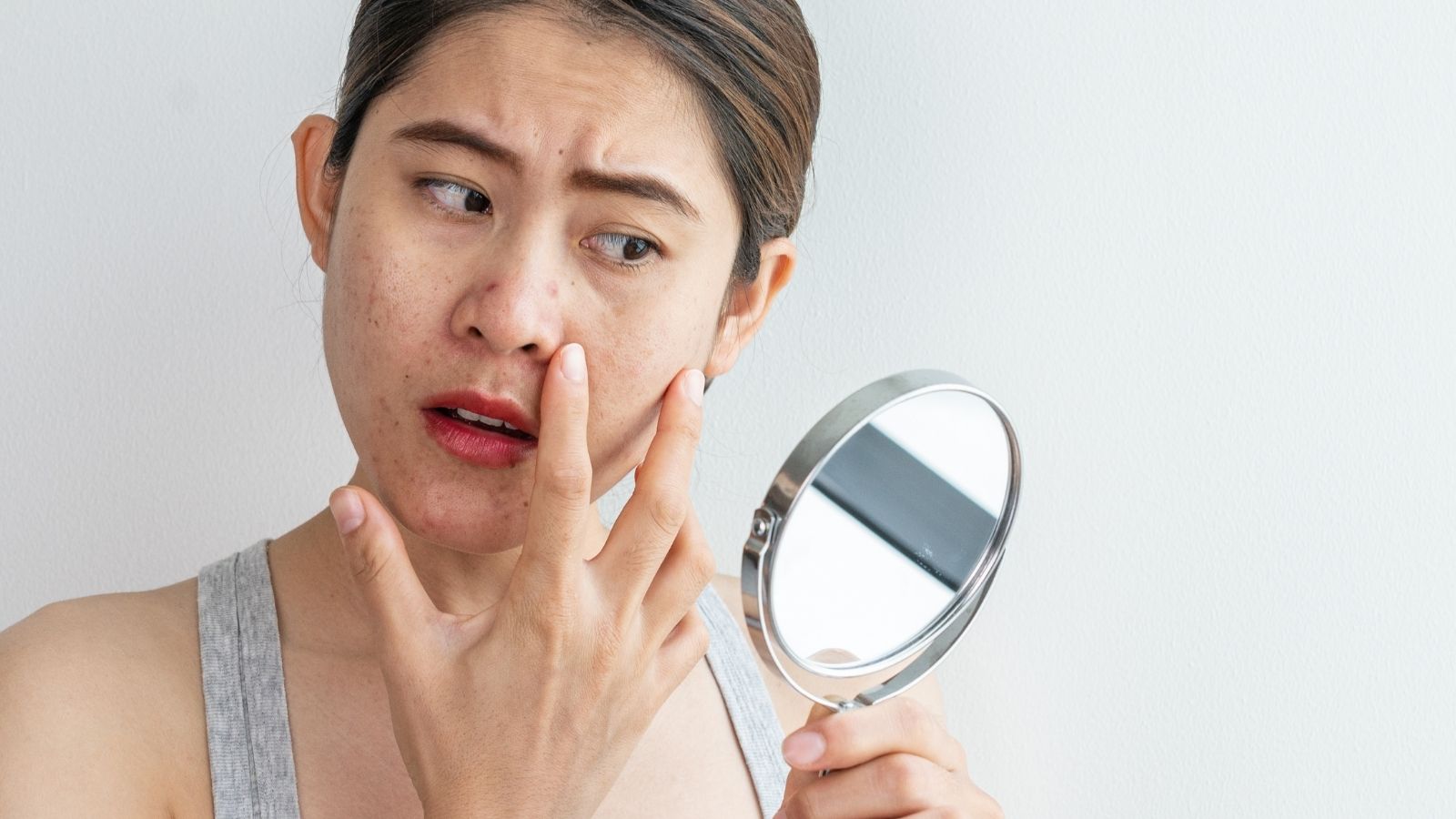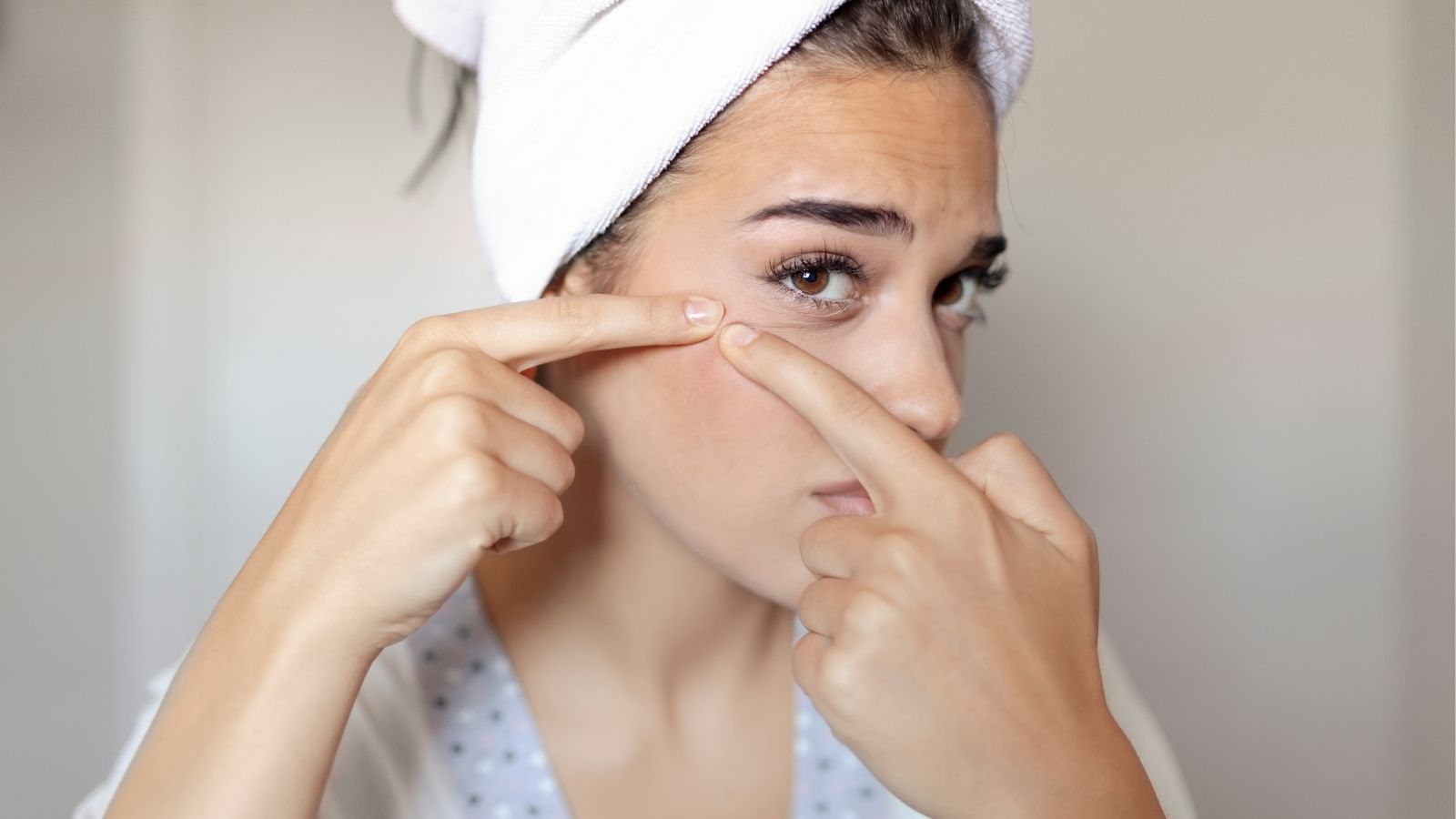Why am I breaking out? The reasons and solutions for every type of spot
Get to the bottom of why you might be breaking out...


If you’re breaking out in spots, you’ll know it’s not a pleasant experience. Most people experience breakouts during their teenage years when hormones are causing havoc, but acne can follow you, or suddenly crop up, well into adult life too.
When your skincare doesn’t seem to be working and covering breakouts with the best foundation or learning how to apply concealer properly isn’t cutting the mustard, you might feel a bit defeated. But getting to the bottom of every spot type and looking at the possible reasons behind them is a great way to start deducing why you're breaking out—and how to stop it from happening.
Why am I breaking out? Acne and spots explained
Spot causes
Breaking out is most commonly associated with oily skin and while specialized skincare for oily skin is useful for that particular issue, any skin type can be susceptible to spots. Causes differ from person to person but generally speaking, spots are a result of two things, blockage and inflammation. “Acne starts as a microcomedone,” says Dr Ana, Aesthetic Docotor at Kat & Co. “Sebum (oil) is over-secreted leading to a blockage when mixed with debris and dead skin cells. Once this blocks the pore there is a perfect environment for bacteria to grow causing pus and inflammation.” But why are some people more susceptible to these blockages than others? Factors like hormones, stress and lifestyle, all play a role in acne and breaking out too
Skin barrier issues
A weakened skin barrier is when the outer layers of your skin (which act as your body's natural barrier to the outside world) become broken or irritated, which can be caused by a few factors. Genetics play a role as skin barriers tend to become slightly weaker with age or external factors like over-scrubbing and UV exposure can also affect it. Signs your skin barrier is disrupted include your skin feeling dry and tight, showing signs of redness, sensitivity, or breakouts. But whether your skin is producing excess oil and pimples or feels painfully dry, your broken skin barrier enables bacteria to get into a pore. This bacteria can thrive, leading to spots and breakouts. This means that by looking after your skin barrier you'll reduce the likelihood of breakouts.
Hormones
Hormonal fluctuations, particularly in teenagers and women that menstruate, can cause acne, Consultant Dermatologist Dr Anjali Mahto explains, "As we hit puberty, our bodies start to produce male hormones known as androgens (in particular, the hormone testosterone). These androgens act on the oil glands, causing them to increase oil production. At the same time, cells lining the hair follicle become ‘sticky’ and start clumping together in a process known as follicular hyperkeratinization. The end result is that pores become blocked with sticky skin cells and excess oil. A bacterium known as Propionibacterium acnes (P. acnes), which lives on the skin, can then colonize these areas, stimulating inflammation and deeper spots."
Stress
Stress doesn't directly cause breakouts but it can worsen them. When we feel stressed, our bodies naturally release something called corticotrophin-releasing hormone (CRH). CRH promotes the skin's production of oil and triggers the release of inflammatory cytokines. The excess oil and the inflammation then lead to breakouts.
Lifestyle behaviors
Some people believe that eating a certain diet that includes dairy and sugar can lead to you breaking out but there is actually little scientific evidence to this. However, other lifestyle factors like using old or dirty cosmetics, hair styling products, wearing hats, and not cleansing properly can cause acne to rear its head.
Sign up to our free daily email for the latest royal and entertainment news, interesting opinion, expert advice on styling and beauty trends, and no-nonsense guides to the health and wellness questions you want answered.
Genetics
"Genetics are thought to play an important role in the development of acne," says Dr Anjali. "Mainly as the size and activity of the oil glands are inherited from our parents. Many people who suffer from acne are likely to have relatives that have also been affected during their lifetime."
Types of acne

You may think you have never have experienced acne in your life but breaking out in spots is actually a symptom of acne. "Acne is a disorder of the pilosebaceous unit of the skin. This consists of a hair follicle and its associated sebaceous or oil gland, explains Dr Anjali. "Blockage or inflammation of the pilosebaceous units will result in acne. Oil glands are found in highest density on the face, back and chest and these are therefore the commonest sites of acne development.”
Essentially, spots are hair follicles that have become clogged and infected resulting in a red, raised bump under the skin. But, if you’ve got acne, it’s likely that you suffer from blackheads too. According to Dr Ana, acne and breaking out can come under one of two categories, “Spots are generally non-inflammatory or inflammatory but you often get a combination of these appearances.”
Non-inflammatory acne (blackheads & whiteheads)
“Non-inflammatory acne (comedonal acne) includes blackheads, which are essentially dead skin cells that have blocked the pores and a reaction with oxygen causes them to darken in appearance, and whiteheads - pores clogged by dead skin cells and sebum underneath the surface of the skin without an opening. These appear like white or skin coloured bumps.” Breaking out doesn't always mean sore, cystic acne, it can be a combination of all types of acne.
Inflammatory acne (papules, pustules, cystic acne and nodules)
Inflammatory acne is typically red and sore, but this category can be further broken down into superficial and deep inflammatory types.
Superficial inflammatory (pustules & papules)
Pustules occur when the blocked pore gets infected, you can often visibly see the pus. Papules look like red spots on the skin, these are caused by bacterial proliferation underneath the surface of the skin and consist mainly of redness and inflammation.
Deep inflammatory (cystic acne & nodules)
Cystic acne is the most severe type of acne and consists of swollen lumps of pus under the skin often with significant inflammation and tenderness. They are often large and challenging to treat. Nodules look like large red tender bumps on the skin, these are usually not filled with pus, unlike cysts.
How to treat acne by type
Like preventing breakouts, curing acne is not one size fits all. Breaking out in spots can be really frustrating and treatments for acne will differ depending on the type of acne you have. To make this a little more simple, we've broken down the main types of breakouts and suggested the most suitable solutions. If acne is causing you significant problems, don't hesitate to talk to your GP who can offer prescription treatments and dermatologist referrals.
Blackheads & whiteheads
“Generally speaking, blackheads and whiteheads can be improved using BHA ie salicylic acid (or sometimes also AHAs) to unblock the pores.,” explains Dr Anjali. “Retinoids are useful in increasing cellular turnover, balance oil production and reduce the ‘stickiness’ of the cells too.”
Pustules & papules
“Pustules and papules can benefit from prescription creams such as benzoyl peroxide and/or topical antibiotics to try out the pus and kill the bacteria. Niacinamide and azaleic acid can be helpful for reducing inflammation. Your GP may prescribe you oral antibiotics if the lesions are persistent.”
If you suffer from pustules but have dry or dehydrated skin, stay away from harsh, stripping cleansers and toners and keep skin supple with a lightweight moisturiser. “Dehydrated skin can exacerbate acne so using a non-comedogenic (pore-blocking) moisturiser is key,” says Dr Anjali. “Be gentle with the cleansing, acne is not a condition that can be cleansed away. Dirt is not the problem as opposed to popular belief.”
Cystic acne & nodules
“Nodules and cysts can be more challenging to treat and may need prescription medications from a specialist dermatologist. There can be high risk of scarring with these types so medical treatment should not be delayed.”
How to prevent acne breakouts

Breaking out in acne might be a sign something has changed in your circumstances. To minimise the chances of a breakout, these are some of the best ways to prevent acne.
Eating a healthy diet
High blood sugar is often attributed to eating a diet heavily made up of processed foods like white bread, white pasta and sweet treats. These foods cause your blood sugar to spike and are often called high glycemic foods. This spike in sugar levels causes an inflammatory response in your body and leads to higher oil production. By avoiding these, your skin has its best shot of regulating itself and staying clear.
Cleansing your skin everyday
A great and consistent skincare routine is a good place to start. “To prevent spots and acne, it is important to regularly but gently exfoliate the skin and control the skin 'shine' by incorporating active skincare ingredients such as niacinamide and salicylic acid,” says Dr Dianni Dai, Resident Doctor at Rejuv Lab London. Knowing your ultimate skincare routine for acne can be tricky but proper AM and PM cleansing will keep bacteria, dirt and excess oil from building up. Including some exfoliation into your routine in the form of acids (AHA or BHAs) is also a great idea for keeping clogged pores at bay.
Avoid touching your face
If you touch your face a lot, bacteria from your fingers can transfer onto your skin and cause breakouts. So, keep your hands clean and avoid touching your face and certainly stop picking or squeezing any pimples that do come up (picking just creates an open channel for bacteria to thrive in) Picking at breakouts can lead to scarring and knowing how to get rid of acne scars can be half the battle of breaking out. Scars can require specialized laser treatments and plenty of patience so it's a good idea to resist picking if you can.
Drink plenty of water
Staying hydrated will enable your body to function properly. Dehydration can lead to your body over-compensating, producing more oil and breaking out more— something that acne sufferers almost always need to avoid. Drink at least 8 glasses of water a day to keep hydration levels up.
Emma North is a Beauty Writer who works for digital titles including woman&home, Woman, Woman’s Weekly, Woman’s Own, Chat and GoodtoKnow. Emma’s career in beauty journalism began with internships at publications including Vogue, Elle, The Telegraph and Glamour. She was then taken under the wing of Funmi Fetto, Contributing Beauty Editor at Vogue where Emma assisted with Funmi’s debut beauty book, Palette.
